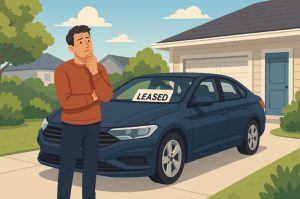Are you considering ending your car lease early but worried about unexpected fees and penalties? You’re not alone. Many Canadians face situations where keeping a leased vehicle no longer fits their lifestyle, budget, or transportation needs.
Whether it’s due to financial constraints, relocation, or a shift toward eco-conscious transportation, breaking a lease is often seen as a difficult and costly task.
Fortunately, there are practical, legal, and potentially penalty-free options to consider. With the right knowledge and planning, you can explore multiple routes to exit a lease with minimal financial impact.
This guide helps you understand your options, responsibilities, and strategies for navigating the car lease exit process in Canada, without the stress of unnecessary penalties. Let’s walk through the choices that may help you move forward confidently.
Why Would You Want to Get Out of a Car Lease Early?

Life is unpredictable, and so are the circumstances that affect your financial or personal mobility needs. If you’re thinking about breaking a lease, there are many reasons that may justify this decision, and they aren’t all financial.
One of the most common reasons is financial hardship. If your income has changed or expenses have increased, monthly lease payments may become unsustainable.
Another motivator could be exceeding your mileage limit, which leads to hefty overage charges that accumulate quickly. Some individuals also outgrow the type of vehicle they’ve leased, families may need more space, or city dwellers might switch to public transit. Environmental concerns, such as wanting to switch to a hybrid or electric vehicle, also play a role in shifting preferences.
Other valid reasons include:
- Relocation to a different city or province
- Redundancy of vehicle use due to work-from-home arrangements
- Desire to refinance into a more affordable or ownership-based plan
- A better lease or purchase deal becomes available
No matter your reason, understanding your motivation can help you determine the best and most cost-effective method to exit the lease early.
What Are the Potential Penalties for Ending a Lease Early?
While it is possible to get out of a lease before your term ends, it usually comes with certain financial implications that vary by leasing company. The most immediate cost is an early termination fee, which is typically a few hundred dollars, depending on your contract terms. However, that’s often just the beginning.
You may also be required to pay depreciation-related costs, especially if the vehicle’s value has significantly decreased since the start of the lease. Additionally, administrative and legal fees could apply if the leasing agreement is being cancelled prematurely.
Potential penalties include:
- Early termination fee (fixed or variable)
- Charges for wear and tear, mileage overage
- Responsibility for remaining lease payments
- Negative impact on your credit score if payments are missed
- Repossession fees, in extreme cases of default
These penalties are designed to help the lessor recoup their investment. Understanding what’s written in the fine print of your lease agreement can help you avoid any surprises later on.
Can You Really Avoid Lease Penalties in Canada?
Yes, it is possible to avoid or significantly reduce lease penalties in Canada, but it requires strategy and sometimes a bit of negotiation. In many cases, lease contracts are not as rigid as they seem. Some leasing companies are open to alternative arrangements if you approach them proactively.
One of the most effective ways to avoid penalties is to transfer the lease to someone else. This allows you to walk away without paying for the remainder of the term, although there might be a small transfer fee involved. Another option is to buy out the lease, especially if the buyout price is lower than the current market value of the vehicle.
Additional ways to reduce or eliminate penalties include:
- Requesting early return negotiations with your dealer
- Exploring lease-swap websites or marketplaces
- Considering refinancing options through the dealership
- Taking advantage of dealer promotions encouraging lease returns
Although not guaranteed, avoiding penalties is realistic when you understand your agreement and explore all your available choices.
What Are Your Options to Get Out of a Car Lease Early Without Penalty?

Getting out of your lease early doesn’t have to be a financial nightmare. In fact, several options are available to Canadians, depending on your goals and financial situation. Below are five practical strategies to exit your lease with minimal or no penalties.
1. Lease Transfer to Another Person
Lease transfers are one of the most commonly used ways to break a lease early in Canada. This involves finding someone willing to take over your lease payments and responsibilities for the remainder of the term. The new lessee assumes the contract, and you walk away, often without incurring early termination fees.
Pros:
- Frees you from lease obligations
- Avoids most penalties
- Widely accepted in Canada
Cons:
- Transfer fees apply
- Lease remains in your name in some cases
- Finding a reliable transferee can be time-consuming
Platforms like LeaseBusters and Kijiji can help facilitate these transactions securely and efficiently.
2. Lease Buyout Strategy
A lease buyout involves paying the remaining amount owed on the lease to gain full ownership of the vehicle. This is a good strategy if the vehicle’s market value is higher than or close to the buyout cost.
When it make sense?
- You like the vehicle and want to keep it
- You’re planning to sell it and recover costs
- You qualify for low-interest financing
Keep in mind that depreciation costs may still apply, and a buyout could be costly upfront—but it gives you complete control over the vehicle.
3. Lease Roll Over or Extension
If you’re not ready to give up the car but need lower payments, extending or rolling over your lease might work. Some leasing companies allow you to renegotiate the contract and extend the lease term.
Benefits:
- Reduced monthly payments
- No penalty for early exit
- More time to make financial arrangements
Drawbacks:
- You may pay more over time due to interest
- Not all leases support rollover terms
This is more suitable for short-term financial setbacks rather than a complete vehicle exit.
4. Lease Return and Early Termination
You can always return the vehicle to the dealer, but this often comes with early termination fees and depreciation charges. Still, if your financial situation is critical, this may be the quickest solution.
Things to consider:
- Request a pre-inspection to estimate fees
- Ask about dealership buy-back programs
- Negotiate to waive some fees if trading for a different vehicle
Although costly, it offers immediate resolution if you’re unable to keep the vehicle.
5. Request Assistance From the Leasing Company
If your financial situation is temporary, some lenders offer relief options like payment deferrals or reduced monthly payments. Communication is key here.
How to approach?
- Be transparent about your situation
- Propose a payment adjustment plan
- Use hardship programs if available
Many lenders are more lenient than you might expect, especially post-pandemic, when many Canadians faced similar challenges.
Key Takeaways and Lease Exit Checklist

Exiting a car lease early in Canada doesn’t always require paying hefty penalties. With the right knowledge, strategy, and preparation, you can navigate this process smoothly and with minimal impact on your finances.
Here’s a quick summary of what you should remember:
- Know your lease terms: Understand your responsibilities and conditions
- Explore your options: Transfer, buyout, rollover, return, or negotiate
- Check vehicle value: Compare it with the lease buyout price
- Avoid missed payments: Protect your credit score
- Get professional advice: Contact your leasing company or a financial advisor
Having a clear checklist ensures you make decisions based on facts, not fear. Be proactive, ask questions, and explore every avenue.
Lease Exit Options in Canada
Before deciding how to exit your lease, it helps to compare the available options.
Below is a simplified table that shows the pros and cons of the four most common strategies:
| Option | Pros | Cons |
| Lease Transfer | Low cost, avoids penalties, fast exit | Requires a new lessee, may involve transfer fees |
| Lease Buyout | Own the vehicle, no ongoing payments | Large upfront cost, depreciation loss |
| Lease Rollover | Lower monthly payments, no penalty | More interest, longer commitment |
| Early Return | Immediate relief, resolves contract | High penalties, credit risk |
Use this comparison to align the best option with your goals and financial readiness.
Is Getting Out of a Lease Early the Right Move for You?

Breaking a car lease early is a significant financial decision, but it can also offer relief or flexibility when your circumstances change. The most important step is to understand your contract and evaluate the short- and long-term consequences of each option.
Ask yourself:
- Can I afford the penalties versus staying the term?
- Is someone else willing to take over the lease?
- Does my dealership offer incentives for early returns?
- Am I planning to buy a different vehicle soon?
By comparing these factors with your needs, you can make a responsible and informed decision. Remember, what works best depends on your financial health and future plans. Choose the option that brings you the most value and the least stress.
Conclusion
Getting out of a car lease early in Canada may feel overwhelming at first, but there are realistic, manageable ways to do it, without paying steep penalties. Whether you choose a lease transfer, buyout, rollover, or seek assistance from your leasing company, each path has its pros and cons.
The key is to take a proactive approach, understand your agreement thoroughly, and weigh your options based on your unique needs. Don’t hesitate to ask questions, negotiate, and explore tools like lease-swapping platforms.
With the right planning, you can exit your lease with confidence and move on to a vehicle or financial arrangement that better suits your life.
FAQs
What is the least expensive way to get out of a car lease?
A lease transfer is often the cheapest option since it avoids termination fees and transfers responsibility to another party.
Will a lease transfer affect my credit score?
If the lease is transferred successfully and payments continue, your credit score is typically unaffected.
Can I return my leased vehicle to the dealer early?
Yes, but early returns usually involve paying penalties, including depreciation and termination fees.
Is buying out a lease better than returning it?
Buying out may be smarter if the vehicle’s value is close to the buyout price, allowing resale or continued use.
Can you break a lease without fees in Canada?
Yes, but only through specific methods like lease transfer or dealership incentives that waive penalties.
Does breaking a lease hurt your credit in Canada?
It can if payments are missed or the lease is reported as defaulted, but not if managed through approved methods.
Are lease transfer companies safe and legal in Canada?
Yes, platforms like LeaseBusters are widely used and reputable for facilitating safe lease transfers.




